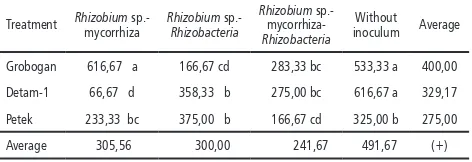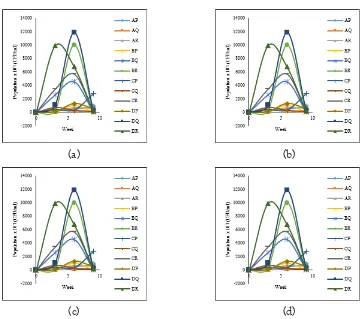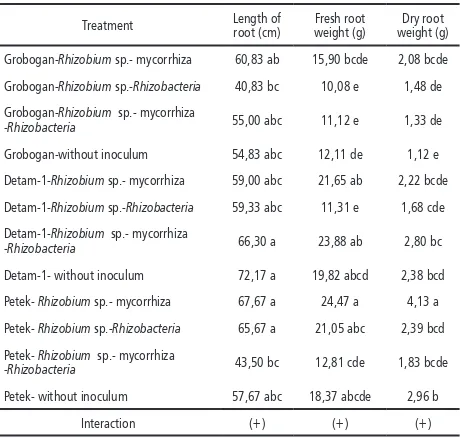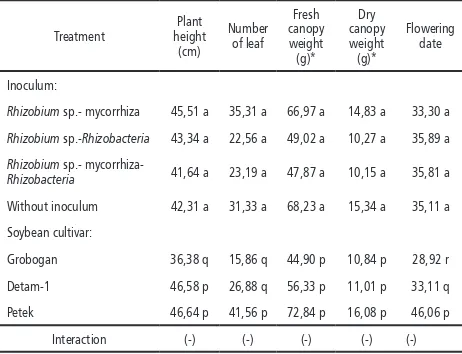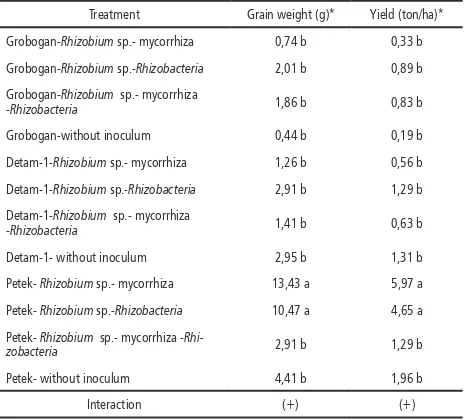INTRODUCTION
Soybean has an important role as a protein source (Rahmat and Yuyun, 1996). Central Bureau of Statistics (Badan Pusat Statistik) [2015] stated that soybean production decreased by 5,38% yearly during the period of 2009 until 2013. Production of soybean was 850.000 tonnes in 2012, but soybean demand was forecasted to be 2.4 million tonnes. It was suggested that demand for tempeh and tofu reach 1.6 million tonnes and black soybean for soy sauce about
650,000 ton (Aditama, 2011). These figures sug-gest that, to catch up with the demand, soybean production needs to be increased by about 1.55 million tonnes.
Intensification such as high-yielding cultivars and biological fertilizer may provide ways to in-crease soybean production. Several soybean cul-tivars, such as Grobogan contains high protein
and also high-yielding (Erliana et al., 2009), while
local cultivar from Boyolali, Petek, is known as
Contribution of
Rhizobium
–Mycorrhiza–Merapi-
indigenous
Rhizobacteria
Association on Growth and Yield of Three
Cultivars Soybean Cultivated on Coastal Sandy Soil
DOI: 10.18196/pt.2017.066.7-14
Linda Kusumastuti*, Agung Astuti, Sarjiyah
Department of Agrotechnology, Faculty of Agriculture, Universitas Muhammadiyah Yogyakarta, Jl. Lingkar Selatan, Kasihan, Bantul, Yogyakarta 55183, Indonesia Telp. 0274 387656,
*Corresponding author, e-mail: lindakusuma22@gmail.com
ABSTRACT
A study was conducted to examine the effect of inoculum association between Rhizobium sp., mycorrhizae and Merapi-indigenous Rhizobacteria on the growth and yield of 3 soybean cultivars, and to determine the best inoculum and cultivars for soybean cultivation on coastal sandy soil. The study was conducted in the Agro-biotechnology and Research Laboratory and experimental station of Faculty of Agriculture, Universitas Muhammadiyah Yogyakarta during the period of September 2015 to June 2016. Experiments were conducted by using coastal sandy soil as planting medium in polybags by employing 4 x 3 factorial experiments, arranged in completely randomised design, and placed under the ield condition. The irst factor used was inoculation treatment consisted of 4 combination of inoculums: (1)Rhizobium sp. – mycorrhizae, (2) Rhizobium sp. – Merapi-indigenous Rhizobacteria, (3) Rhizobium sp. – mycor-rhizae – Merapi-indigenous Rhizobacteria, and (4) without inoculation. The second factor was soybean cultivars consisted of 3 varieties: (1) Grobogan, (2) Detam-1, and (3) Petek. Observation was carried out on nodulation, mycorrhizal effect, Rhizobacterial population dynamics, plant growth and yield. The results showed that Rhizobium sp.–mycorrhizae inoculated on Petek increased root growth, leaf area and yield (5,97 tonnes/ha). Rhizobium sp.–mycorrhizae inoculation only increased diameter of nodules. It was also observed that the best soybean cultivar for coastal sandy soil was Petek.
Keywords: Soybean cultivars, Rhizobium sp., Mycorrhizae, Rhizobacteria indigenous of Merapi, Coastal sandy soil
ABSTRAK
Tujuan penelitian adalah mengetahui pengaruh asosiasi inokulum pada pertumbuhan dan hasil 3 varietas kedelai dan menetapkan asosiasi inokulum dan varietas yang sesuai untuk pengembangan kedelai di lahan pasir pantai. Penelitian dilaksanakan di Laboratorium Agrobioteknologi, Laboratorium Penelitian dan lahan percobaan Fakultas Pertanian, Universitas Muhammadiyah Yogyakarta pada bulan September 2015 hingga Juni 2016. Penelitian menggunakan rancangan percobaan faktorial (4 x 3) yang disusun dalam Rancangan Acak Lengkap (RAL) dengan media tanam pasir pantai. Faktor pertama adalah perlakuan inokulum yang terdiri dari 4 macam yaitu (1) Rhizobium sp.-Mikoriza, (2) Rhizobiumsp.-Rhizobacteri indigenous Merapi, (3) Rhizobium sp.-Mikoriza-Rhizobacteri indigenous Merapi dan (4) tanpa inokulum. Faktor kedua adalah kultivar kedelai yang terdiri dari 3 varietas yaitu (1) Grobogan, (2) Detam-1 dan (3) Petek. Pengamatan dilakukan terhadap aktivitas nodulasi, pengaruh mikoriza, dinamika populasi Rhizobacteri, pertumbuhan perakaran, pertumbuhan vegetatif, dan hasil. Hasil penelitian menunjukkan bahwa inokulasi Rhizobium sp. - mikoriza hanya berpengaruh terhadap diameter nodul dan inokulasi Rhizobium sp.-mikoriza pada varietas Petek nyata meningkatkan pertumbuhan perakaran, luas daun dan hasil biji (5,97 ton/h).
drought resistant cultivar, and Detam-1 cultivar contains high protein (45.36%) as well as high-yielding (3.45 tonnes/ha, [Balitkabi, 2008]).
Extensification may conducted by using mar-ginal area (Arie, 2013), such as coastal area which has the potential use of 1.060.000 ha. One of the drawback of coastal area is that it has low fertil-ity, low nutrient and high porosity. Application of biological fertilizer may provide the alterna-tive way to resolve coastal sandy soil problem. Some microorganisms are known to improve soil
fertility such as Rhizobium sp., mycorrhiza and
several indigenous Rhizobacteria such as
Merapi-indigenous Rhizobacteria. Rhizobium sp. is known to reserve Nitrogen, while mycorrhiza reserve
Phos-phor, and an indigenous Rhizobacteria, Merapi-
in-digenous Rhizobacteria, has been demonstrated to improve plant resistance to drought (Gunawan,
2014; Muhammad et al., 2014).
Double inoculation of soybean with
Rhizobi-um sp. and mycorrhiza resulted in the increase of
nitrogen on coastal sandy soil and kept humidity of rhizosphere (Gunawan, 2014). On the other
hand, single inoculation using Rhizobium sp. did
not increase plant dry weight and leaf area yet (Lilik, 2005). Previous study also demonstrated
that double inoculation using Rhizobium sp. and
mycorrhiza, and single inoculation using only Rhizobium sp. resulted not significantly differ-ent effect on the number of pod, grain weight and yield. Double inoculation of soybean using Rhizobium sp.-mycorrhiza cultivated on coastal sandy soil produced only 25% of yield potential.
Similarly, osmotolerant Rhizobacteria-Rhizobium
sp. association did not increase soybean growth
and yield (Ngadiman et al., 2014). It is
anticipat-ed that inoculation of Grobogan cultivar using Rhizobium sp.-mycorrhiza – Merapi-indigenous Rhizobacteria, cultivated on coastal sandy soil, will increase soybean growth and yield which.
This study was, therefore, conducted to exam-ine the contribution of inoculum association
between Rhizobium sp., mycorrhizae and
Merapi-indigenous Rhizobacteria on the growth and yield
of 3 soybean cultivars, and to determine the best inoculum and cultivars for soybean cultivation on coastal sandy soil.
MATERIALS AND METHODS
Materials used in this study were Rhizobium
sp., Merapi-indigenous Rhizobacteria MB and MD
isolates (Agung_Astuti, 2012 personal communi-cation), crude inoculum of mycorrhiza, Grobo-gan, Petek and Detam-1 soybean cultivars. The study was conducted in the Agro-biotechnology Research Laboratory and experimental station of Faculty of Agriculture, Universitas Muhammadi-yah Yogyakarta during the period of September 2015 to June 2016.
Experiments were conducted by using coastal sandy soil as planting medium in polybags, ar-ranged in completely randomized design (CRD) of 4 x 3 factorial experiments and placed under the field condition. The first factor used was in-oculation treatment consisted of 4 combinations
of inoculum: (1) Rhizobium sp. – Mycorrhiza, (2)
Rhizobium sp. – Merapi-indigenous Rhizobacteria, (3) Rhizobium sp. – Mycorrhiza –
Merapi-indige-nous Rhizobacteria, and (4) without inoculation.
The second factor was soybean cultivars consist-ed of 3 varieties: (1) Grobogan, (2) Detam-1, and (3) Petek. Observation was carried out on
nodu-lation, mycorrhizal effect, Rhizobacterial
popula-tion dynamics, plant growth and yield.
The final results were analysed using ANOVA
(analysis of variance) with α of 5%. The
RESULTS AND DISCUSSION
The Effect of treatment on root nodulations Rhizobium sp. infection is indicated by the formation of root nodule which indicates the compatibility with the plant. Table 1 shows the average number of nodules parameter presented following inoculation.
Table 1. Average number of nodule, nodule effective-ness, nodule weight and diameter in the ninth week
Treatment Number of nodule*
Effective nodule
Rhizobium sp.- mycorrhiza 8,76 a 65,42 a 0,38 a 3,74 a
Rhizobium sp.-Rhizobacteria 2,78 a 37,78 a 0,05 b 1,59 a
Rhizobium sp.-
mycorrhiza-Rhizobacteria 2,56 a 49,17 a 0,12 b 2,46 a
Without inoculum 1,78 a 20,83 a 0,15 b 1,22 a
Soybean cultivar:
Grobogan 6,42 p 49,17 p 0,31 p 2,86 p
Detam-1 4,08 p 31,11 p 0,14 p 1,72 p
Petek 1,33 p 49,62 p 0,08 p 2,18 p
Interaction (-) (-) (-) (-)
Note: numbers followed by the same letter showed no significant difference based on the F test α 5% and DMRT.
(-) No interaction between treatments * square root data transformation *** arc-sin and square root data transformation
It was observed that soybean cultivar did
not significantly affect nodulation as Rhizobium
sp. was found effectively nodulated all soybean cultivar. Soybean cultivar which was inoculated by Rhizobium sp.-mycorrhiza showed significantly different number of nodule (Lilik, 2005; Yudhy
and Inoriah, 2009). Ayu et al. (2013) suggested
that the formation of nodule and nodule activity were influenced by phosphor from the mycorrhi-za activities. The average of nodulation activities is presented in Table 1. It was the more effective nodule formed, the more nitrogen fixed and subsequently more chlorophyll and enzyme syn-thesised. The increase of chlorophyll and enzyme synthesis resulted in the increase of photosynthe-sis and vegetative, generative growth (yield) (Ram-dana and Retno, 2015). Mycorrhiza is known
to increase water availability in the rhizosphere, which will result in the effective nodule and in-creased weight of nodule (Nike-Triwahyuningsih, 2004). The result showed that the formation of nodule in coastal sandy soil was longer than in fertile soil. Mycorrhiza is also known to increase diameter and effectiveness of nodule. The larger nodule diameter, the higher nodule effectivity as the larger diameter gives indication that the
development of Rhizobium sp. inside nodule is
good. Small nodules indicate slow growing tis-sue bacteroid, which subsequently reduced the effectiveness of nitrogen fixation (Ramdana and Retno 2015).
Effect of treatment on the efectivity of mycorrhizal inoculation
The results of this study demonstrated that inoculum and cultivar treatment have the same effect on mycorrhizal-infected root percentage. Rhizobium sp.-mycorrhiza association, however, demonstrated higher mycorrhizal-infected root
percentage during 9 week. Rhizobium sp.
pro-duces Nod Factor as growth regulator for mycor-rhiza, therefore Nod factor induces colonization and development of mycorrhiza through nod gen induction (van Brussel et al., 1986 cit Xie et
al.,1995). Table 2 showed the number of spores
as the indicator of mycorrhizal growth, while the average of mycorrhizal-infected root percentage is presented in Table 3.
Table 2. Average number of mycorrhizal spore (spore/ ml) x104 in the ninth week
Treatment Rhizobium sp.- mycorrhiza
Grobogan 616,67 a 166,67 cd 283,33 bc 533,33 a 400,00
Detam-1 66,67 d 358,33 b 275,00 bc 616,67 a 329,17
Petek 233,33 bc 375,00 b 166,67 cd 325,00 b 275,00
Average 305,56 300,00 241,67 491,67 (+)
Notes: numbers followed by the same letter showed no significant difference based on the F test α 5% and DMRT.
Table 3. Average of mycorrhizal-infected root percent-age in the ninth week
Treatment Mycorrhiza infection percentage (%)**
Inoculum:
Rhizobium sp.- mycorrhiza 98,89 a
Rhizobium sp.-Rhizobacteria 95,56 a
Rhizobium sp.- mycorrhiza-Rhizobacteria 97,78 a
Without inoculum 94,44 a
Soybean cultivar:
Grobogan 95,00 p
Detam-1 97,50 p
Petek 97,50 p
Interaction (-)
Notes: numbers followed by the same letter showed that no significantly difference based on the F test α 5% and DMRT.
(-) No interaction between treatments ** arc-sin data transformation
The different root exudates of each cultivar may contribute to the difference of microorgan-isms thrive in the rhizosphere, which may also affect the mycorrhizal growth. The presence of microorganism compatible with each cultivar may also increase plant growth. It was suggested that the factors which affect plant host may also
affect to mycorrhizal growth (Tutik et al., 2016).
The effect of treatmet on activity of Merapi- indige-nous Rhizobacteria
After inoculation was observed Merapi-
indig-enous Rhizobacteria populationdynamics popula-tion. Microbial population dynamics for 9 weeks was presented in Figure 1.
Figure 1. Population dynamics: (a) total bacteria, (b) other bacteria, (c) Merapi indigenous Rhizobacteria, MB isolate and (d) Merapi indigenous Rhizobacteria, MD isolate on three soybean cultivars
Remark:
A = Rhizobium sp.-mycorrhiza P = Grobogan B = Rhizobium sp.-Rhizobacteria Q = Detam-1 C = Rhizobium sp.-mycorrhiza Rhizobacteria R = Petek D = Without inoculum
(a) (b)
Figure 1 showed that group of Rhizobacteria which compatible to each cultivar. MB and MD isolates in combination with mycorrhiza and Rhizobium sp. demonstrated the ability to adapt well as evidenced by the increase of popula-tion in the sixth week. Figure 1 (c) showed that Grobogan cultivar inoculated with MB isolate
in combination with Rhizobium sp-mycorrhiza
demonstrated good adaption as shown by
en-tering the log phase in the 0 – 3rd week, while
other treatment still in the adaptation phase. On the other hand, the population of MD isolate (Figure 1.d) on all of treatment showed tendency to decrease, with the exception of Detam-1
cul-tivar inoculated with Rhizobium
sp.-mycorrhiza-Rhizobacteria that the Rhizobacteria reached the highest level of log phase until the sixth week, and reached the death phase after nine weeks. It was also observed that inoculation with
mycor-rhiza increased the Merapi-indigenous
Rhizobac-teria growth. Marcia et al. (2011) suggested that the positive effect of one microbe to another is attributed by the metabolite secretion.
Root proliferation of three soybean cultivars culti-vated on coastal sandy soil
Root proliferation illustrates the spread of the roots on the media. It was observed that inoculum and cultivar treatments resulted in a similar effect on root proliferation due to the presence of indigenous mycorrhizal spore and the facts that all treatments were infected by my-corrhiza including treatment without inoculum. Mycorrhiza-legumes association may increase the availability of phosphor, as well as the increase of nitrogenase activity which promoted root prolif-eration (Sylvia et al., 2005).
Root system is influenced by both genetic fac-tors and growth media. Most of soil nutrients are absorbed from soil solution through the root. It
was found that inoculum and cultivar treatments showed interacting effect on root length. The uinoculated Detam-1 cultivar showed tendency to have longer root as mycorrhiza-legume
associa-tion may increase root proliferaassocia-tion (Sylvia et al.,
2005). The average length of root, fresh and dry weight of root are presented in Table 4.
Table 4. Average length of root, fresh and dry weight of root after nine weeks
Treatment Length of root (cm)
Fresh root weight (g)
Dry root weight (g)
Grobogan-Rhizobium sp.- mycorrhiza 60,83 ab 15,90 bcde 2,08 bcde
Grobogan-Rhizobium sp.-Rhizobacteria 40,83 bc 10,08 e 1,48 de
Grobogan-Rhizobium sp.- mycorrhiza
-Rhizobacteria 55,00 abc 11,12 e 1,33 de
Grobogan-without inoculum 54,83 abc 12,11 de 1,12 e
Detam-1-Rhizobium sp.- mycorrhiza 59,00 abc 21,65 ab 2,22 bcde
Detam-1-Rhizobium sp.-Rhizobacteria 59,33 abc 11,31 e 1,68 cde
Detam-1-Rhizobium sp.- mycorrhiza
-Rhizobacteria 66,30 a 23,88 ab 2,80 bc
Detam-1- without inoculum 72,17 a 19,82 abcd 2,38 bcd
Petek- Rhizobium sp.- mycorrhiza 67,67 a 24,47 a 4,13 a
Petek- Rhizobium sp.-Rhizobacteria 65,67 a 21,05 abc 2,39 bcd
Petek- Rhizobium sp.- mycorrhiza
-Rhizobacteria 43,50 bc 12,81 cde 1,83 bcde
Petek- without inoculum 57,67 abc 18,37 abcde 2,96 b
Interaction (+) (+) (+)
Notes: numbers followed by the same letter showed that no significantly difference based on the F test α 5% and DMRT.
(+) There was interaction between treatments
Rhizobium sp.-mycorrhiza-Petek interaction re-sulted in nutrient absorption and high photosyn-thesis accumulation on the root, which increased fresh and dry roots. Such increased was sup-ported by the high number of leaf and leaf area on Petek. It was suggested that factors affecting photosynthesis were genetic and the absorption
of nutrients from soil (Gardner et al., 1991).
Vegetative growth of three soybean cultivars culti-vated on Coastal Sandy Soil
canopy weight. Several studies also suggest that
cultivar affects plant height (Wayan et al., 2011;
Rosi and Santi, 2012), number of leaf (Wayan et.
al., 2011) and flowering date (Anna, 2015; Rosi
and Santi, 2012). Suhartina (2005) showed that Detam-1 height was higher than Grobogan and Petek suggesting that every cultivar brings out dif-ferent character. Every cultivar has difdif-ferent abil-ity to absorb nutrients resulting in different
num-ber of leaf and leaf area (Yutono, 1988 in:Farida,
2004). Gardner et al. (1991) also suggested that
every cultivar showed different photosynthetic rates, while flowering date is affected by genetic factors, length of days and temperature (Suyamto
and Musalamah, 2010).
Table 5. Average plant height, number of leaf, fresh and dry canopy weight, after nine weeks and the lowering date
Rhizobium sp.- mycorrhiza 45,51 a 35,31 a 66,97 a 14,83 a 33,30 a
Rhizobium sp.-Rhizobacteria 43,34 a 22,56 a 49,02 a 10,27 a 35,89 a
Rhizobium sp.-
mycorrhiza-Rhizobacteria 41,64 a 23,19 a 47,87 a 10,15 a 35,81 a
Without inoculum 42,31 a 31,33 a 68,23 a 15,34 a 35,11 a
Soybean cultivar:
Grobogan 36,38 q 15,86 q 44,90 p 10,84 p 28,92 r
Detam-1 46,58 p 26,88 q 56,33 p 11,01 p 33,11 q
Petek 46,64 p 41,56 p 72,84 p 16,08 p 46,06 p
Interaction (-) (-) (-) (-) (-)
Note: numbers followed by the same letter showed no significant difference based on the F test α 5% and DMRT.
(-) No interaction between treatments * square root data transformation
Leaf area was found affected by cultivar and inoculum. Average leaf area in the ninth week is presented in Table 7. Petek, in combination with Rhizobium sp.-mycorrhiza resulted in significantly higher leaf area. Every cultivar has different abil-ity to absorb nutrients resulting in different leaf
area (Yutono, 1988 in: Farida, 2004), while the
inoculum increased nutrient availability (note:
there is no data supporting this notion). Mycorrhiza inoculation on soybean cultivated on coastal san-dy soil increased nitrogen and kept the humidity surrounding the rhizosphere (Gunawan, 2014).
Table 6. Average leaf area in the ninth week (cm2)*
Treatment Rhizobium sp.- mycorrhiza
Detam-1 837,00 cd 1347,00 bcd 854,33 cd 1938,67 abc 1244,25
Petek 2779,67 a 1066,67 cd 1190,33 cd 2383,33 ab 1855,00
Average 1453,56 1037,67 921,67 1595,78 (+)
Notes: numbers followed by the same letter showed no significant difference based on the F test α 5% and DMRT.
(-) No interaction between treatments * square root data transformation
Yield Components of Three Cultivars Soybean Culti-vated on Coastal Sandy Soil
The productivity of plant was the ultimate goal of cultivation, including the cultivation of soybeans. Table 7 shows the average soybean yield components.
Table 7. Average number of pod, illed-pod percentage,
pod dry weight and weight of 100 grains
Treatment Number
Rhizobium sp.- mycorrhiza 128,83 a 24,93 a 11,64 a 4,75 a
Rhizobium sp.-Rhizobacteria 142,75 a 26,97 a 12,59 a 5,19 a
Rhizobium sp.-
mycorrhiza-Rhizobacteria 115,50 a 15,51 a 10,94 a 4,57 a
Without inoculum 128,44 a 18,49 a 10,14 a 4,51 a
Soybean cultivar:
Grobogan 45,62 r 6,72 q 7,06 r 5,51 p
Detam-1 127,40 q 19,27 pq 15,78 p 4,49 p
Petek 213,63 p 38,43 p 11,14 q 4,26 p
Interaction (-) (-) (-) (-)
Note: numbers followed by the same letter showed no significant difference based on the F test α 5% and DMRT.
(-) No interaction between treatments * square root data transformation
Cultivar was found to affect the number of total pods (Yudhy and Inoriah, 2009), filled-pod
sp.-Rhizobacteria association also showed tendency to have the best result on number of pod, pod dry weight, grain weight and weight of 100 grains. Some of PGPR bacteria have been demonstrated to develop association which resulted in the in-crease of nodulation and nitrogen absorption of
legume (Figueiredo et al., 2011. Petek was the
cul-tivar with the highest number of pod and filled-pod percentage, while Detam-1 and Grobogan were the cultivars with highest pod dry weight, and the highest weight of 100 grains, respectively.
Table 8. Average grain weight and yield
Treatment Grain weight (g)* Yield (ton/ha)*
Grobogan-Rhizobium sp.- mycorrhiza 0,74 b 0,33 b
Grobogan-Rhizobium sp.-Rhizobacteria 2,01 b 0,89 b
Grobogan-Rhizobium sp.- mycorrhiza
-Rhizobacteria 1,86 b 0,83 b
Grobogan-without inoculum 0,44 b 0,19 b
Detam-1-Rhizobium sp.- mycorrhiza 1,26 b 0,56 b
Detam-1-Rhizobium sp.-Rhizobacteria 2,91 b 1,29 b
Detam-1-Rhizobium sp.- mycorrhiza
-Rhizobacteria 1,41 b 0,63 b
Detam-1- without inoculum 2,95 b 1,31 b
Petek- Rhizobium sp.- mycorrhiza 13,43 a 5,97 a
Petek- Rhizobium sp.-Rhizobacteria 10,47 a 4,65 a
Petek- Rhizobium sp.- mycorrhiza -
Rhi-zobacteria 2,91 b 1,29 b
Petek- without inoculum 4,41 b 1,96 b
Interaction (+) (+)
Notes: numbers followed by the same letter showed that no significantly difference based on the F test α 5% and DMRT.
(-) No interaction between treatments * square root data transformation
Grain weight and yield on Petek in
combina-tion with Rhizobium sp.-mycorrhiza-Rhizobacteria
were significantly higher than other treatments. Rhizobium sp.- mycorrhiza or Rhizobium sp.-Rhizobacteria inoculation were better than third inoculation. It is known that grain weight and yield is supported by length root, root fresh and dry weight as a result of inoculation. The longer and the more complex roots, the greater so water and nutrient absorption (Lakitan, 2007). The availability of nutrients, combined with
dif-ference number of leaves and leaf area of each
cultivar required for photosynthesis, will affect the filling of seed which leads to the increase of grain weight and yield. It should also be noted that each cultivar has different adaptation to the environment (Yudhy and Inoriah, 2009), which means that Petek cultivar is more adap-tive to coastal sandy soil as it is regarded as quite
drought resistant cultivar (Sri et al., 2015).
CONCLUSION
The present study demonstrated that
inocu-lation of Petek cultivar using Rhizobium
sp.-my-corrhiza resulted in significantly increased root growth, leaf area, and yield (5.97 ton/ha) and diameter of nodule. Therefore, it is concluded
that association between Rhizobium sp-mycorrhiza
and Rhizobium sp.-Merapi-indigenous Rhizobacteria with Petek is suitable for soybean cultivation on coastal sandy soil.
ACKNOWLEDGEMENTS
The authors would like to thank PT. Indo-food Sukses Makmur for providing research grants through Indofood Riset Nugraha 2015/2016 program.
REFERENCES
Adetama, D. S. 2011. Analisis Permintaan Kedelai. Fakultas Eko-nomi Universitas Indonesia. Jakarta. 14 p.
Agung_Astuti. 2012. Isolasi Rhizobakteri indigenous Lahan Pasir Vulkanik Merapi yang Tahan Terhadap Cekaman Kekeringan. Scientiic Seminar in Faculty Agriculture, UMY.
Anna E., Diana S. H. and Isman N. 2015. Respon Morfologis dan Fisiologis Beberapa Varietas Kedelai (Glycine max (L.) Merril) di Tanah Masam. Jurnal Online Agroekoteknologi. 3 (II): 507-514.
Arie. 2013. Angan Swasembada Pangan. http://www.kompa-siana.com/ariefebstyo/angan-swasembada-pangan_552995 c8f17e614a0ad623a8. Diakses 10 Juli 2015.
Ayu M., Rosmayanti dan Luthi A. M. 2013. Pertumbuhan dan Produksi Beberapa Varietas Kedelai terhadap Inokulasi
BradyRhizobium. Jurnal Online Agroteknologi. 1(2):15-23.
BPS. 2015. Produksi Kedelai. http://BPS.go.id. Diakses 2 Juni 2015.
Erliana G, Sri S. A. dan Sri W. 2009. Varietas Unggul Kedelai Untuk Bahan Baku Industri Pangan. Jurnal Litbang Pertanian. 28 (3):79-87.
Farida K. 2004. Pengaruh Inokulasi Rhizobium – CMA terhadap Pertumbuhan dan Hasil Dua Varietas Kedelai pada Tanah Entisol. Skripsi Fakultas Pertanian UMY. Yogyakarta. Figueiredo, M., Ademir S., Helio A. and Mario de A. 2011.
Biodi-versity and The Potential of PGPR: Plant-Microorganism In-teractions in Microbial Ecology of Tropical Soils. Nova Science Publisher. Inc. New York. p.332.
Gardner, F. P., R. Brent P. dan Roger L. M. 1991. Fisiologi Tanaman Budidaya. UI Press. Jakarta. 428 hal.
Gunawan B. 2014. Manajemen Sumberdaya Lahan. Lembaga Penelitian, Publikasi dan Pengabdian Masyarakat Universitas Muhammadiyah Yogyakarta. Yogyakarta. Hal. 147-160. Lakitan, B. 2007. Dasar – Dasar Fisiologi Tumbuhan. PT. Raja
Graindo Persada. Jakarta
Lilik U. 2005. Pengaruh Inokulasi Rhizobium-VAM dan Bahan Organik Terhadap Pertumbuhan dan Hasil Tanaman Kedelai di Lahan Pasir Pantai. Jurnal Agr-UMY. XIII (1): 20-31. Marcia F., Ademir S., Helio A and Mario A. 2011. Biodiversity and
The Potential of PGPR: Plant-microorganism Interactions. Nova Scince Publisher, Inc. New York. p.332.
Muhamad H. R., Agung_Astuti dan Haryono. 2014. Pengujian Toleransi Terhadap Cekaman Kekeringan pada Berbagai Va-rietas Padi yang Diinokulasi Rhizobacteri indigenous Merapi.
http://thesis.umy.ac.id/datapublik/t34775.pdf. Diakses 10 Juli 2015. Hal. 4-10.
Nasih W. Y. 2009. Membangun Kesuburan Tanah di Lahan Mar-ginal. Jurnal Ilmu Tanah dan Lingkungan. IX (2):137-141. Nike-Triwahyuningsih, Agung_Astuti, Lilik U., Bambang H. I., Budiyono dan F. Khusna. 2004. Aktivitas Nodulasi pada Kedelai Edamame dan Wilis pada Perlakuan Inokulasi Ganda
Rhizobium-Cendawan Mikoriza Arbuskula di Tanah Entisol
Berkapur. Jurnal AgrUMY XII (2):65-78.
Ngadiman, Sri W., Triwibowo Y. dan Marta R. T. 2014. Peranan Inokulasi Ganda Rhizobia Pemnodul Akar dan Rhizobacteri
Osmotoleran terhadap Pertumbuhan Tanaman Kedelai dalam Kondisi Cekaman Kekeringan. http://opac.lib.ugm.ac.id/index. php?mod=penelitian_detail&sub=PenelitianDetail&act=view &typ=html&buku_id=428551&obyek_id=4. Diakses 11 Juli 2015.
Rahmat R. dan Yuyun Y. 1996. Kedelai, Budidaya dan Pasca Panen. Kanisius. Yogyakarta. Hal. 12.
Ramdana S. dan Retno P. 2015. Rhizobium: Pemanfaatannya sebagai Bakteri Penambat Nitrogen. Info Teknis EBONI 12 (1):51-64.
Rosi W. dan Santi D. A. 2012. Tanggap Beberapa Varietas Kedelai terhadap Pemberian Pupuk Organik Cair Bio P 2000Z. Prosid-ing Seminar Nasional. Purwokerto.
Sri S., Didik I., Putu S. dan Jaka W. 2015. Kebutuhan Air, Eisiensi Penggunaan Air dan Ketahanan Kekeringan Kultivar Kedelai. Agritech 35 (1):114-120.
Suhartina. 2005. Deskripsi Varietas Unggul Kacang-kacangan dan Umbi-umbian. Balai Penelitian Tanaman Kacang-kacan-gan dan Umbi-umbian. Malang. 154 hal.
Suyamto dan Musalamah. 2010. Kemampuan Berbunga, Tingkat Keguguran Bunga dan Potensi Hasil Beberapa Varietas Kede-lai. Buletin Plasma Nutfah 16 (1):38-43.
Sylvia, David M., Jeffry J. M., Peter G. H. and David A. Z. 2005. Principles and Applictions of Soil Microbiology. Pearson Edu-cation Inc., Upper Saddle River. New Jersey. 640 p.
Tutik N., Kristanti I. P. dan Dini E. 2016. Isolasi Mikoriza Vesikular Arbuskular pada Lahan Kering di Jawa Timur. http://personal.
its.ac.id/iles/pub/5146-tutiknurhidayatissi-EDITING%20 KE%202%20ISOLASI.doc. Diakses 18 Mei 2016.
Wayan W., Ari A. dan Nihla F. 2011. Respon Berbagai Varietas Kedelai (Glycine max (L.) Merril) terhadap Sterilisasi Tanah dan Inokulasi dengan Mikoriza Arbuskular. Agroteksos. 21 (I): 19-28.
Xie, Zhi-Ping, Christian S., Horst V., Andreas W., Said J., William J. B., Regina V. and Thomas B. 1995. Rhizobial Nodulation Factors Stimulate Mycorrhizal Colonization of Nodulating and Nonnodulating Soybeans. Plant Physiol. 108:1519-1525. Yudhy H. B. dan E. Inoriah. 2009. Dampak Inokulasi Ganda
